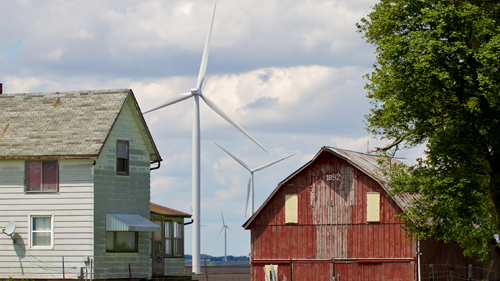Wind turbine developments have no effect on property values of nearby homes and farms, according to new research from the University of Guelph.
Published in a recent issue of the Canadian Journal of Agricultural Economics, the study is believed the first peer-reviewed study on this issue in Canada.
The study has received significant media attention in Canada and beyond, including articles in the National Post andThe Daily Mail in the United Kingdom and reports on CTV News, CP 24 News, Global News, CBC News, and Yahoo! News.
It was conducted by Richard Vyn, a professor in the Department of Food, Agricultural and Resource Economics, and Ryan McCullough, a former U of G graduate student and now a policy analyst for Health Canada.
They analyzed more than 7,000 home and farm sales in Melancthon Township and 10 surrounding townships in Dufferin, Grey, Simcoe and Wellington counties. Melancthon, located about 100 kilometres northwest of Toronto, is home to one of Ontario’s first and largest wind farms; 133 wind turbines were erected between 2005 and 2008.
The study included sales data over an eight-year period – from 2002 to 2010 – to capture property values before, during and after the wind farm’s development. During that period, more than 1,000 homes and farms were resold — some multiple times, which allowed for repeat sales analysis.
Using a method common in real estate studies, the researchers created six models accounting for the impact on property values of proximity to the wind farm development and turbine visibility, as well as a combination of these two factors.
In every case, they found wind farms had “no statistically significant effect” on property values.
The researchers had expected to find a negative correlation, especially for residential properties.
“This may help address the controversy that exists in Ontario regarding the impact of wind turbines on property values,” Vyn said.
A current court battle in Ontario about wind energy developments involves families in Huron County and the K2 Wind Energy Power Project.
Across the province, residents have called on the government to delay wind farm development until the impacts are better understood.
Such public opposition is what prompted the research, Vyn said.
“It’s been in the news for a while now, and it seems to be generating more and more concerns among local residents. I wanted to see whether the stories people are telling and the concerns that they are expressing show up in the sales data.”
Before now, no scientific study in Ontario had focused on wind turbines and property values, and few studies anywhere used actual sales data, which “gives you a much more accurate picture of what’s going on,” Vyn said.
“Our results do not corroborate concerns raised by residents regarding potential negative impacts of turbines on property values.”
However, Vyn said, the study examined the effect on property values on homes and farms only as a group. “It does not preclude that there may be some impacts on individual properties.”
The findings may help inform further policy discussion and developments for wind energy in Ontario, he said.
Vyn plans to expand his research to include all of Ontario. He is especially interested in the effect of public attitudes toward wind turbine developments.
“Melancthon Township was one of the first major wind farms in Ontario. Since that time, the attention that the issue has received and the public backlash has really escalated; the wind farms that have developed since then have received a lot more resistance and attention,” Vyn said.
“I’m very curious about whether we will get similar results across Ontario or whether there will be variation — if we will find a relationship between the amount of resistance a municipality receives to a wind farm going up and potential impacts on property values.”
http://www.uoguelph.ca/fare/FARE-talk/index.html#windturbines



